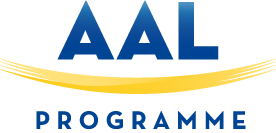IANVS
Home » Success Stories » IANVS
01. Introduction
The IANVS project, funded through the AAL Programme, aimed to develop a 3D location sensor infrastructure to support independent living for older adults in serviced homes. The system monitors safety, detects emergencies, and provides comfort services while maintaining user privacy. The project also developed fall detection services, enabling older adults to live independently and safely while offering caregivers timely notifications of potential issues.
02. Summary of the project aims and objectives
The primary objective of the IANVS project was to create a preventive device that enhances the self-reliance of older adults through real-time monitoring. By integrating 3D location sensors and IoT beacons, IANVS supports older adults in remaining at home independently while providing caregivers with insights and alerts related to safety and daily activities.
03.Product development and key features
Main Product: IANVS The IANVS device includes:
- 3D location sensors: Deployed in elderly serviced homes to track activity patterns.
- Fall detection system: Automatically detects falls and sends alerts to caregivers.
- Home automation services: Offers comfort and safety through automated features.
- Real-time monitoring: Supports independent living by monitoring activities of daily living (ADLs) and interacting with end-users when needed.
04. Partners
The IANVS project involved 4 partners from multiple countries
- MagicView (SME, Belgium) [Coordinator]
- ARX-IT (SME, Switzerland)
- Fraunhofer AICOS (R&D, Portugal)
- TERZ (End-user, Switzerland)
05.Impact on participating in an AAL project
Key takeaways
- AAL project participation secured follow-on funding from AAL (EMILIO) and potentially from Horizon Europe (SENECA).
- Established networks with partners like IMEC and VILANS, fostering continued collaboration.
- Validated the product's value proposition through user testing, focusing on older adults rather than just caregivers.
- Opened access to new markets in the Netherlands and other EU countries.
06. Main learnings from developing a solution through an AAL project
Organisational impacts
- The project emphasised the importance of end-user focus, leading to the development of practical, target-oriented solutions.
- User involvement revealed the need to expand from caregiver-centric to older adult-centric solutions.
- Collaboration with technology partners (Fraunhofer and IMEC) strengthened the technical capabilities of the product.
07. Impact on networking and collaboration
Building partnerships
- Established collaboration with new technology and user-testing partners through AAL meetings.
- The project brought together a small, well-coordinated consortium, facilitating efficient cooperation.
08. Perceived benefits of participating in AAL Support Actions
- Benefited from coaching and mentoring through AAL2Business.
- Gained knowledge in market readiness, value proposition development, and commercialisation strategies.
- Participation in AAL Forums helped increase visibility and peer exchange.
09. How AAL supported development and market adoption
Market expansion
- Initially targeted healthcare personnel but later adapted to older adults based on user feedback.
- The AAL Programme helped identify practical use cases, emphasising the integration of monitoring and quality-of-life metrics.
10. Challenges encountered
- COVID-19 pandemic: Disrupted pilot testing, which was later resumed under the EMILIO project.
- Market credibility: As a small company, MagicView faced challenges in establishing long-term market presence.
- Upscaling needs: Collaboration with larger companies became essential for successful commercialisation.
11. Actions needed to launch product
- Final integration testing: in varied industrial environments to ensure broad compatibility.
- Targeted dissemination to industry: through trade shows and B2B channels.
- Additional investment: to scale the solution for medium-to-large manufacturing clients.
- Partnering with system integrators: to offer IANVS as a plug-and-play module.
10. Next steps
End Users
- Manufacturing operators, safety officers, and process engineers in smart factory environments.
Expected Impact
- Enhanced situational awareness and decision-making support.
- Reduced operator stress and error rates.
- Increased efficiency in HRC workflows.
Target Paying Customers
- Industrial automation companies, system integrators, and manufacturers adopting Industry 4.0 solutions.
- Focus on building sustainable business models and securing long-term investment.
